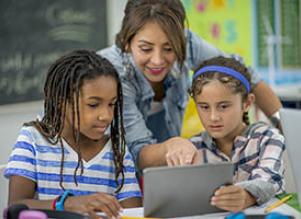6/4/2019
What Makes EdTech Most Useful? Hint: It’s About Teaching
The presence of educational technology—or edtech, as it is often called—is a given in most public-school classrooms. Whiteboards, laptop carts, and even students’ personal smartphone devices (when used for educational purposes!) are undeniable components of schools today, a state of affairs that may lead to the assumption that technology is a good and necessary thing with the potential to positively transform teaching and learning.
However, this assumption was challenged in a recent opinion piece by Thomas Arnett, a senior researcher at the nonpartisan, innovation-focused Clayton Christensen Institute. In a piece for the institute’s blog, Arnett posited that the way people think of edtech as an entity separate from the exchange between teachers and students “misses the mark.”
The overlooked power of edtech
It’s not so much that Arnett disputed the potential of edtech; rather, he argued that people tend to view it through an “inaccurate paradigm.” Too often, he stated, edtech is put on the same level as teaching, as if both have an equal capacity to influence academic outcomes for students. In his view, that framework is problematic because the real (and overlooked) power of edtech lies in its ability to alter how teachers work with students. Thus, Arnett opined, edtech should be embraced not for any inherent value it brings from the technology angle but for its potential to help teachers connect more meaningfully with students.
To underscore his point, Arnett offered several examples of how edtech often “indirectly” influences student outcomes through teachers, even though we tend to assume that it can or should directly or independently impact students. Consider adaptive learning software that meets students where they are and helps them move forward at their own pace—a form of edtech that, according to Arnett, can help students “gain exposure and practice with content targeted at their particular learning needs,” thereby having a direct impact on student achievement.
However, Arnett went on to point out that adaptive learning software’s greatest impact can actually happen indirectly: While students are individually engaged with adaptive software programs, the teacher can find opportunities for small-group instruction. Further, adaptive learning software that provides immediate data on student performance allows teachers to more quickly differentiate instruction—when adaptive software provides real-time, pinpointed data, the teacher knows exactly where a student is struggling and is able to group students with similar needs, saving time and frustration for everyone involved. The very art and science of teaching, then, could be altered through the accompanying use of edtech tools.

The value of online playlists
Arnett also pointed to online playlists (which, for the uninitiated, can be thought of as digitized textbooks or lesson plans). In 2017, Education Week reporter Benjamin Herold described playlists as algorithm-crafted, personalized learning tools that can deliver customized lessons to individual students; for instance, in a math class that uses playlists, students have the opportunity to work at their own pace by completing online lessons curated especially for them.
As Arnett explained, online playlists can be thought of as an updated version of an enduring classroom standby—textbooks—that “add multimedia, easier access, and adaptability to a function that textbooks have served for centuries.” Beyond listing the potential impact of these tools on student learning, Arnett also presented playlists as another way to free up teachers' time by reducing the amount of energy devoted to “planning and delivering direct instruction.” More specifically, Arnett envisioned teachers doing the following with the aid of online playlists:
-
Facilitating projects
-
Implementing mastery-based learning
-
Giving students deeper feedback on their work
-
Providing students with coaching or mentorship
-
Facilitating opportunities to build students’ social capital
-
Building connections and partnerships with students’ families
Tools in teachers' tool belts
A 2016 post on the Cult of Pedagogy blog offered another take on digital playlists when site editor Jennifer Gonzalez interviewed Rhode Island teacher Tracy Enos about the online playlists that Enos had crafted for her Language Arts students. While the tasks included on the playlists were not as self-driven as those one might find in a math class (when students are perhaps more likely to work at their own pace), Gonzalez observed that “individual tasks can be customized to meet individual needs” and acknowledged how Enos made “space in each playlist for purely individualized tasks” so students could identify particular things they needed to address in their work.
The Cult of Pedagogy post also mentioned how allowing students to monitor their own workload through an online playlist may help teachers concentrate their efforts on those who need the most assistance, which is exactly the paradigm shift Arnett would like to see when it comes to assessing the value of edtech. Simply put, the technology is not necessarily revolutionary all by itself, but—citing the work of education researcher John Hattie—Arnett put forward this argument: “The teaching practices edtech helps to enable have substantially more impact on student learning than standalone edtech interventions.” This hearkens back to a previous piece penned by Arnett on what the senior researcher believes is at the core of edtech: teachers.
“The real potential of online learning,” Arnett stated in the 2018 piece, “comes not from the tools themselves, but from what teachers can do using their tool belt.”

